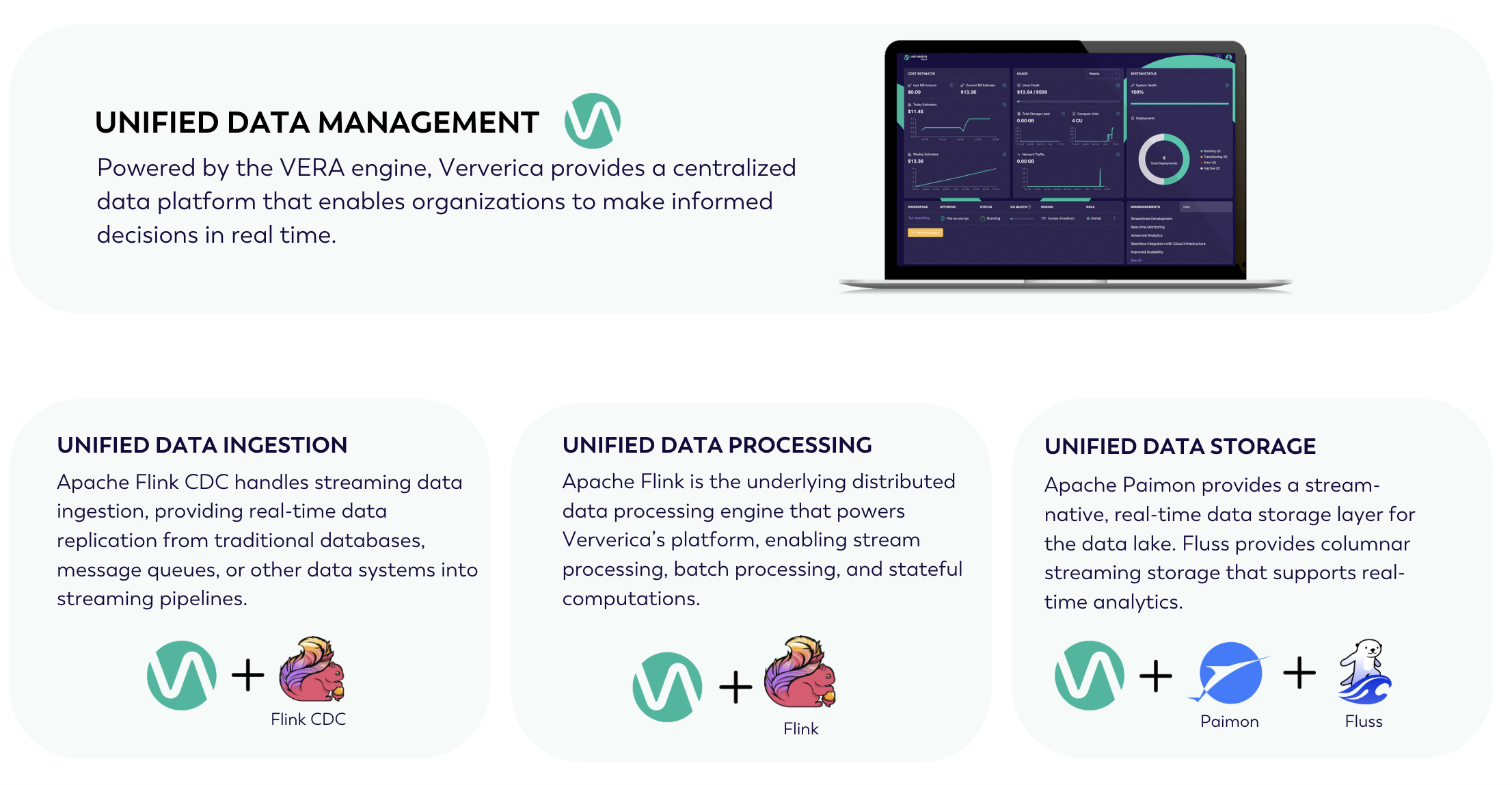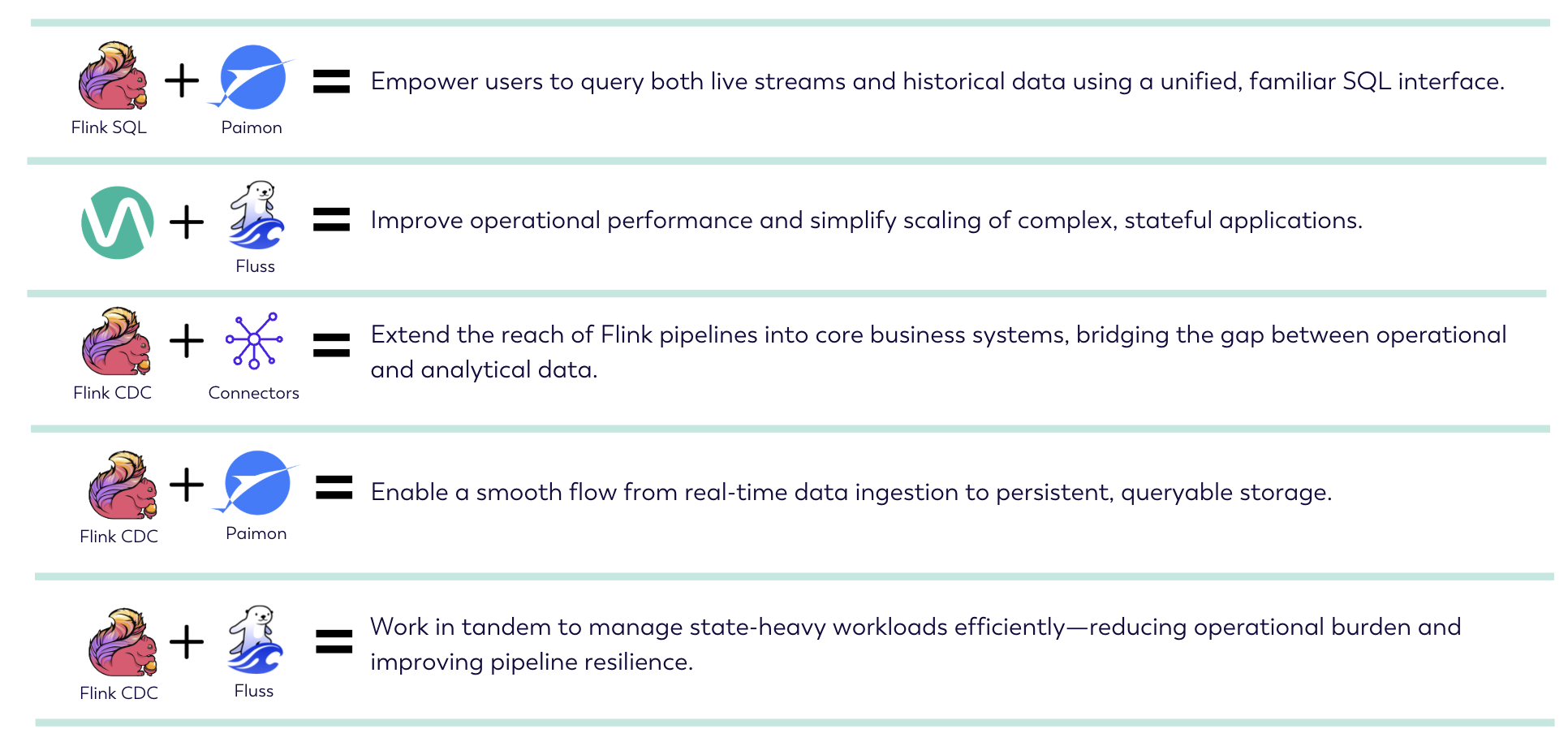About The Ververica Ecosystem
The Ververica ecosystem brings together core technologies for stream and batch processing into a cohesive, cloud-native platform. These components work together to power real-time applications, stateful processing, and unified data analytics.
As summarized in the image below, the Ververica Unified Streaming Data Platform is a one-stop-shop for data teams, providing unified data management, ingestion, processing, and storage.

Key Ecosystem Components
The core components in the Ververica ecosystem include open-source adjacent software and enterprise components and tools.
| Component | Role in the Ecosystem |
|---|---|
| Ververica Unified Streaming Data Platform | Sits at the center of Ververica's ecosystem, built on Apache Flink and powered by VERA. It is the operational layer that ties everything together. |
| Apache Flink | Powers real-time and batch stream processing with stateful, scalable, and fault-tolerant capabilities, serving as the foundation for the platform with rich APIs and interactive SQL support. |
| Apache Paimon | Acts as unified data lake storage for both real-time and historical analytics. |
| Flink CDC | Enables real-time data ingestion from transactional databases. |
| Fluss | Improves Flink’s scalability and resilience with stream-native state storage. |
| Streamhouse | Unifies streaming and batch processing by integrating Apache Flink, Apache Paimon, Flink CDC, and Fluss to handle real-time data ingestion, processing, state management, and storage, enabling low-latency analytics and seamless querying of both real-time and historical data. |
How the Core Components Work Together in the Ecosystem
The Ververica ecosystem combines powerful, purpose-built components to deliver seamless real-time data processing from end to end. Each plays a distinct role, yet their true value emerges through integration. Together, they form a unified foundation for building reliable, scalable, and intelligent streaming data solutions.
End-to-End Flow

Ingestion - Flink CDC captures real-time changes from transactional databases, turning operational data into a continuous stream of events.
Processing - Apache Flink, orchestrated by the Ververica Unified Streaming Data Platform, transforms and analyzes streaming data as it arrives, applying business logic, enriching context, and enabling instant decisions.
State Management - Fluss provides low-latency, stream-native state storage. It ensures reliable checkpointing, efficient recovery, and high-performance state handling for large-scale Flink jobs.
Storage - Apache Paimon persists the processed data, enabling both real-time access and historical queries across time. It supports incremental updates and time-travel analytics.
Unification - Streamhouse brings it all together by merging ingestion, stream processing, state management, and storage into a cohesive architecture. It enables seamless transitions between streaming and batch workloads, powered by SQL and Flink-native APIs.
Component Synergies

Streamhouse integrates these components to handle the entire data flow. You can also use each component (Flink for processing, Paimon for storage, Fluss for state management, and CDC for ingestion) independently. This modularity allows organizations to adopt features and capabilities of Ververica Unified Streaming Data Platform incrementally while maintaining interoperability with existing systems.
Related Topics
Learn more about the open-source adjacent software technologies and enterprise components and tools:
To learn more about our platform, see Ververica Unified Streaming Data Platform, Platform Pillars, VERA Engine, and VERA's Core Pillars.
See also the Apache Flink CDC documentation, Apache Flink project, and Apache Paimon project.